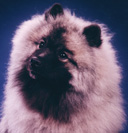

Topics covered are: This section will cover the companion dog. This may be a retired show dog, an
obedience dog, an agility dog that is also a Companion animal. The primary focus will
be the routine care of a dog that is a family pet. It makes no difference whether the
Companion is a dog or bitch, because the article will assume the dog is spayed or
neutered, as all strictly Companion pets should be. It will be referred to as
"Companion" or "dog" or "he", even though it may be a "she". As with previous articles,
interjected are my beliefs, others may differ. The routine, care, feeding are what has
worked for me. Others may have different results and routines.
The main things to be concerned with in a Companion are diet and general care.
Involving the Companion in family activities is a given. Vacations, holidays and special
events such as children's sports activities should involve the Companion when
possible. After all, the definition of a companion is a buddy, a fellow, an associate, a
mate.
When you get your Companion, whether it is a young or older kees, enroll in an
obedience class at a local kennel club. This will give both of you a good start at
forming a lasting bond. You will learn how to train your dog effectively and your dog
will learn how to interpret what you mean. Even if you have trained other kees before,
each dog needs socialization and going to a training class is important for a
well-rounded individual. The Companion should always stay current on vaccinations and be pest and worm
free. If you walk your dog in public parks, this will require more monitoring.
Based upon the age of the Companion, the diet will be adjusted to the age and
amount of activity. A Kees over 2 years of age and under 7 years with average activity
should have food with a protein level of 23-26% and a fat level of 13-15%. Do not
assume that dogs can live and be healthy on meat alone. If you are cooking
completely for your dog without using commercial foods at all, the rule of thumb is 22%
protein (sources: meat, fish, eggs, cheese, beans), 20% oils, 58% from the cereal/grain
family. If you and your dog are not so active together, less fat and protein will be
necessary. A young dog will require more. A puppy even more, but do refer to the info
on the Puppy for suggestions. An older dog requires less, but refer to the info on the
Senior Dog. As
with all dog foods, steer clear of foods preserved with anything other than Vitamins C
and E. Cooking for your dog is suggested because it is the only way to ensure good
food sources along with fresh ingredients full of vitamins, minerals and enzymes. Try
adding the Dog Stew and/or Choice Chow along with the Cupcake recipe. [Recipes are
in the Recipe section.] The amount of food given will vary
by individual, but on the
average about 2 cups of dry food per day with the suggested recipes will maintain an
average Kees. I suggest feeding all dogs individually, if you have more than one.
Food should be served at room temperature and in the same location each day. You
should always know how much each dog is eating so you can tell when their
maintenance amount needs to be adjusted or when they aren't feeling well. Kees over
18 months should be fed once a day with food down for 30 minutes and removed after
that time. I don't believe in free feeding dogs. They assimilate their food much better
if fed once a day [excluding puppies, pregnant females, special cases].
For stress and overall health, the vitamins I give are 1,000 mgs of Vit C, 400 IU Vit E,
6mg Pantothenic Acid [Vit B6] and 30 mg Zinc every other day along with the herbal
additives. The Vit C is for overall health and stress. Vit E is for boosting the blood
supply, circulatory system, immune system, effects of air pollution, rejuvenating, overall
skin and coat health. B6 is for increasing lifespan, immune system, adrenal glands
(hormonal system). Zinc is for enzyme production, healthy skin and coat, expedites
healing. Zinc is lost through stress and should be added back in for a Companion
because it helps the Vit E to be used. Add yogurt (about 1 tablespoon of plain
unflavored) on top of the food three times a week. This will restore the good bacteria in
the digestive tract and help with any gassy problems your dog may have. If your
Companion eats dirt or grass, let them. They are attempting to add minerals and
herbs to their diet and this is a natural way for them to do it.
I cannot stress enough the benefits of bee pollen to any dogs diet! It has natural
enzymes and it helps strengthen the immune system. It is one of nature's most perfect
foods full of protein, vitamins, minerals & micronutrient. It comes in granulated or
capsule forms. Add fresh garlic [not garlic salt or seasoning in a shaker] in the amount
of 1/2 a clove a day. It is a natural antiviral, antibiotic, antifungal. It is good for worms,
parasites, digestive problems. Because most Companion Kees are from questionable
backgrounds, they can use the extra boost these vitamins give to help their weak
genetic systems.
About half the phone calls I receive from owners of Companion kees, have to do with
diet. The owners have the dog on some kind of enzyme additive because their vet
suggested it for the problems the dog is having digesting food properly. The first thing I
tell them is to get on a good diet [without corn meal as the first ingredient!] & gradually
get rid of the enzyme additive, replacing it with the bee pollen & yogurt. In addition,
adding dandelion, garlic, ginger, papaya, peppermint and slippery elm bark is good
for digestive disorders.
Be sure the water the Companion drinks is as pure as possible. Spring fed well water
in uncontaminated areas is best.
During the winter months when you have the heat on in your home, your Companion
may need extra moisturizing for the skin and coat. There are many things you can to
help this. First would be to feed a good quality dog food with the vitamins and herbs
added. This will help the coat from the inside. Additional oils may be needed for dry
coat and skin that are not required during the other months. Sunflower oil, oil of
evening primrose and flax seed oils can be used singly or in combination and given
every other day.
From the outside, coat sprays can be used that contain natural emollients like
rosemary, blackberry leaves, lemon, horsetail and red clover tops. To use, make a tea
out of the herbs, dilute with about 1/2 water and mix with your coat spray or use alone.
Golden seal root can be mixed as a powder and added in a diluted amount to your coat
spray. This is good for overall skin / coat health combatting eczema and other skin
disorders. If fleas are a problem, try a few drops of pennyroyal, tree tea, eucalyptus,
cajeput, rue, wormwood or citronella oil in the coat spray. [Never use essential oils
directly on the skin undiluted!] Green Ban (from Australia) has a wonderful line of
herbal dog care products including a great natural flea powder, skin soother and
shampoo. [Consider using the suggestions on coat sprays from the Show Dog info.]
Since your companion shares your daily life, chances are they will be traveling with
you
when you visit friends or relatives, for holidays or daily quick trips. One thing to be
concerned with is for them to wear proper ID on their collar. A rolled leather collar is
best for a kees. Consider getting your pet tattooed by a local vet or grooming clinic in
addition to the ID. After getting the tattoo, register it with a national registry such as
National Dog Registry or Tattoo-A-Pet. The latest in pet ids is the microchip. I have recently started to use the microchip instead or in addition to the tattoo. The registry service I recommend for the microchips is the CAR (Companion Animal Recovery) offered by the AKC. See www.akc.org for details. Take along the rabies tag with
certificate on trips.
When traveling on overnight trips, take along the same food you
feed everyday along with a supply of water. Some dogs are sensitive to changes in
their water supply. You won't know the quality of water available where you are going,
most likely. Always walk your dog on a leash when away from home even if they are
the most well-trained obedience dog.
Clean up stools using a baggy as a glove to pick
up with, invert it and dispose in a well-ventilated trash container (such as those at rest
areas). Avoid allowing your dog to explore the feces of other animals. Don't allow your
dog to walk in marshy areas where they can pick up giardia or any number of other
bacteria/protozoa. When exercising your dog on the road, avoid busy traffic areas if
possible. Stop at rest areas as opposed to pulling over on the side of an interstate.
Never leave your dog in a hot car for any length of time. Never allow your dog to
travel
with any part of his head out of the window. Dogs should always travel in crates and
not be allowed to wander all over your car while traveling. The crate is like a seat belt.
Take along rawhide chews, cow hooves or other favorite toys that don't have sharp
edges to jab your dog while riding in the car.
If you are staying in a motel, don't allow your dog to be alone in the room. Always
crate your dog in the room when you cannot supervise them (for example while you
sleep). Some dogs are sensitive to treatments used on motel carpets. Take along a
coat spray and waterless shampoo in the case your dog becomes itchy. [Air & foreign
travel, camping not covered.]
Your Companion should not need very many baths in a year. The only times you
may
want to wash him would be if he gets into something foul, has skin/coat problems or
has a pest problem. Weekly grooming sessions for maintenance grooming are a good
way to instill the human animal bond with your dog. Do a complete grooming, clipping
toenails if necessary. Check the ears, eyes and pads of feet. Trim the hair between
the pads flush with the pads. Check the teeth and scale if you see any buildup.
Because your Companion is altered, shedding will not happen as often. When it does,
using a wide tooth comb or rake will help get dead coat out. Warm baths two weeks
apart will expedite coat blowing.
If you have an "only" Companion dog, they will benefit from some time with
members of
their own species.
Exercise is important to overall health. Take your dog for walks and be sure that
includes some running time for them to stretch. If you dog retrieves, this is great
exercise. A ball, Frisbee or stick will all provide great stretch of the muscles along with
good heart and lung exercise.
Remember when using herbs & vitamins, some can have disastrous side effects
when
used in excess or in the wrong applications. They can cause illness or even death.
When in doubt, read further and consult someone more knowledgeable and your
veterinarian. Don't use something your aren't sure of.
The herbs [& related] I mix in the Companion Dog herbal formula are:
Benefits of the above: nettle - rich in iron to help with the circulatory system. It is rich in Vit A, C, D and
calcium & protein.
Oil of evening Primrose - helps alleviate toxins related to an unhealthy diet. Helps
stop growth of many kinds of cancer. Stimulates stomach action to help liver & spleen
conditions. Very high in gamma linolenic acid (GLA) [an essential fatty acid] which aids
in manufacturing prostaglandin. Studies are showing this to stimulate the hormone
system which may be blocked in some cases. [not to be used in epileptics]
garlic - natural antibiotic, antiviral, antifungal. It rejuvenates all parts of the body.
Great for circulatory system. It also is a natural flea fighter and digestive calmer.
slippery elm - for gastric distress [colitis], draws out impurities, heals all parts of the
body
peppermint - for digestion, poor appetite & gas
dandelion - fresh, chopped. Rich in iron, copper & potassium great for the heart.
parsley - cleanses the liver, tones the body, builds resistance, strengthens
digestion, source of Vit C, iron, manganese, calcium, phosphorus.
alfalfa - helps in weight gain, stimulates appetite, good for muscle/joint pains,
contains calcium, phosphorus, iron, potassium, magnesium, enzymes, choline, sodium,
silicon, Vits A B, D, K & P
cayenne - good for heart muscles & worm control
rosemary leaves - good tonic for reproductive organs. Relieves depression. One of
the most powerful herbs to stimulate the nervous system. Rich in Vit A & C, calcium.
Good for the circulatory system.
sea vegetables - rich in vitamins, minerals and thyroid gland stimulant. Helps with
any joint problems.
spirulina - provides nutrients to the body when it is not getting enough in regular
diet. Good during or after battle with a chronic disease. It helps with vitality, purifies and
builds the blood. Easy to digest. Rich in protein, chlorophyll and essential fatty acids.
bee pollen - one of nature's most perfect foods. Contains vitamins, minerals,
enzymes, amino acids. Improves stamina, endurance, increased energy.
red clover - an anticoagulant, helpful with heart problems. Just being realized in
cancer treatments with success. Also for skin complaints & arthritis.
sage - rich in Vit A, C & B complex, a lot of calcium & potassium. Good for the
brain, to improve memory, for mental exhaustion & improve the ability to concentrate.
echinacea - stimulates the immune system, is an antibacterial & antiviral
Hips xrays, stifle checks and blood work testing are not done by less reputable
folks.
This is due to the fact that these Companions come from questionable backgrounds,
having ancestors that have weak immune and maladjusted psychology systems due to
lack of proper nutrition and socialization through generations of such poor conditions. I
am not saying that kees from reputable sources are free from problems, but at least
their nutrition and care through many generations would not be neglected because
they are not raised as money making prospects. [Again, assuming responsible
breeders are truly responsible.] Kees from reputable sources are bred [assumption] to
the AKC Breed Standard. Others are not. These basic assumptions become important
when the health of the dog is addressed.
*[FYI: In making the assumption above [ie most Companion kees come from
questionable breeders], the statistics were used obtained from a 6month period of AKC
numbers of Kees and kees litters registered. Projecting that six month figure, in a
year's time 1,664 kees litters were produced resulting in 8,028 individual kees
registrations. In order for KCA members [of which there are approx 300& assuming
they are ethical/repsonsible] to have produced that number of kees, each member
would have to average 5.54 litters per year, which is highly unlikely. In attempting to
project the most number of kees bred from reputable sources, it is more likely that each
KCA member breeds 2 litters per year of 4.8 puppies [average litter size based upon
AKC figures even though many KCA members do not breed], resulting in 2,880
individual registrations. That would account for 35% of the total kees registered,
maximum number. The rest, 5,148 or 65% minimum, are coming from somewhere
else.]
A healthy, well raised kees with a quality background whose parents (and
ancestors) have been tested clear of genetic problems can *ONLY* be obtained from a
reputable breeder.
How do you know they are reputable? Ask questions. Ask if they belong to any
keeshond clubs, all-breed dog clubs, obedience clubs. Ask for references, then follow
through by checking them. Ask for names and phone numbers of previous dog buyers.
If the breder is reluctant to offer the info, you don't need to buy from them. Visit the
breeder and find out the conditions their dogs are kept in. Do they have
a backyard full? Do they have many breeds of dogs? Do they show their dogs in AKC
competition? Can they provide you information & guidance once you get a puppy?
Will they be willing to have you call them when the dog is a year old? Will they take
the dog back if you are confronted with a change in your lifestyle that requires you can
no longer keep the dog? If they don't ask for spay and neuter on your companion, this
is a red flag. If they advertise in the newspaper, this is a red flag. If they have the
*parents on premises* that can be a red flag. If the breeder doesn't ask many
questions of you, then that is a red flag. Obtain a copy of the prospective puppy's
pedigree and call the someone in a national kees club (Keeshond Club of America or
The American Keeshond Society) and find out if these are known bloodlines or just a
mishmash of pet shop quality dogs.
[For a list of
Dogs Available pages click here.]
If the breeder thinks you are asking too many questions, don't deal with them.
If the breeder can't produce the paper work to prove the sire and dam are clear of
genetic defects, then chances are they are not or they were never tested.
Don't take less than the best, even if it is not intended to be a *show dog*. You
want
your kees to look like a kees when its grown. Remember, AKC papers are *not* an
indication of quality AND they are not a guarantee that your puppy is a result of a
keeshond bred to a keeshond. You want the pup to be healthy and able to walk when
it's 8 years old. You should intend to keep it for life and that life shouldn't be a few
years.
-THE END-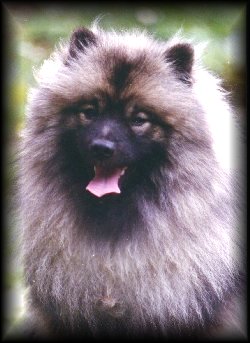 Image: "Tony", Ch. Sylvan On Broadway
Image: "Tony", Ch. Sylvan On Broadway
Bred, owned & shown by: Maureen Larsen, Sylvan Kees WA
This page is maintained by Donna Stekli, last updated 10/28/2002
![]()
![]() Intro
Intro
![]() Care of the
Companion
Care of the
Companion
(nutrition, vaccinations, rearing, etc.)
![]() Traveling with your
Companion
Traveling with your
Companion
![]() Coat care
Coat care
![]() Benefits of socializing with
other dogs
Benefits of socializing with
other dogs
![]() Exercise
Exercise
![]() Herbs to use
Herbs to use
![]() Where do most Kees come
from?
Where do most Kees come
from?
![]() Where to get a healthy
Kees
Where to get a healthy
Kees
![]() Intro
Intro
![]()
Care

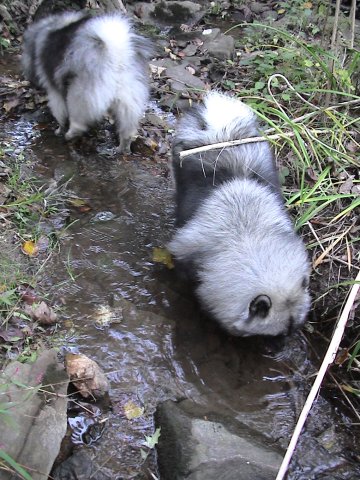
![]()
Traveling with your Companion
![]()
Coat care
![]()
Benefits of Socializing with other dogs
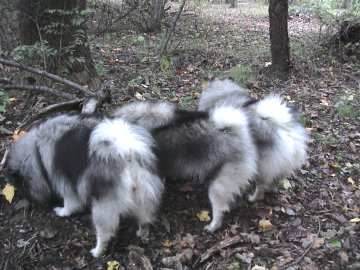 If a neighbor dog is available, some fun time with that dog would be
good socialization on a regular basis. Dogs really do need to remember they are dogs
and do benefit from having time with others like themselves in addition to being your
Companion.
If a neighbor dog is available, some fun time with that dog would be
good socialization on a regular basis. Dogs really do need to remember they are dogs
and do benefit from having time with others like themselves in addition to being your
Companion.
![]()
Exercise
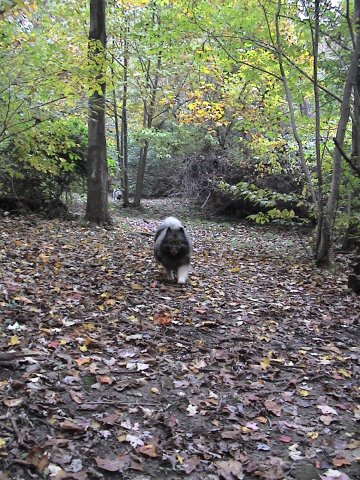
![]()
Herbs to use
Nettles, Oil of Evening Primrose, Garlic, Slippery Elm Bark, Peppermint, Dandelion,
Parsley, Alfalfa, Cayenne, Rosemary Leaves, Sea Vegetables, Spirulina, Bee Pollen,
Red Clover, Sage, Echinacea.
![]()
Where do most kees come from?
Assumptions: Where do the Kees come from?
In addressing the Companion dog as a whole, I will assume that most are obtained
from backyard breeders, pet shops or as rescued dogs.* It is important to note, that in
these situations, the health of the dog cannot be as easily predicted as with a dog from
a known background. Those Companions that are obtained from a reputable breeder
will be more easily raised because the breeder knows the background of the dog and
the familial history. They will be able to share diet tips, health care tips and things you
may have to watch out for as your dog grows up. Companions from other backgrounds
are not as fortunate to have their familial health history known. Because of this, allergic
conditions, digestive disorders, skin and coat conditions cannot be as easily treated
because the genetics are usually weak.
![]()
Where to get a healthy Kees
Click here to return to topics list.
![]()
![]()
